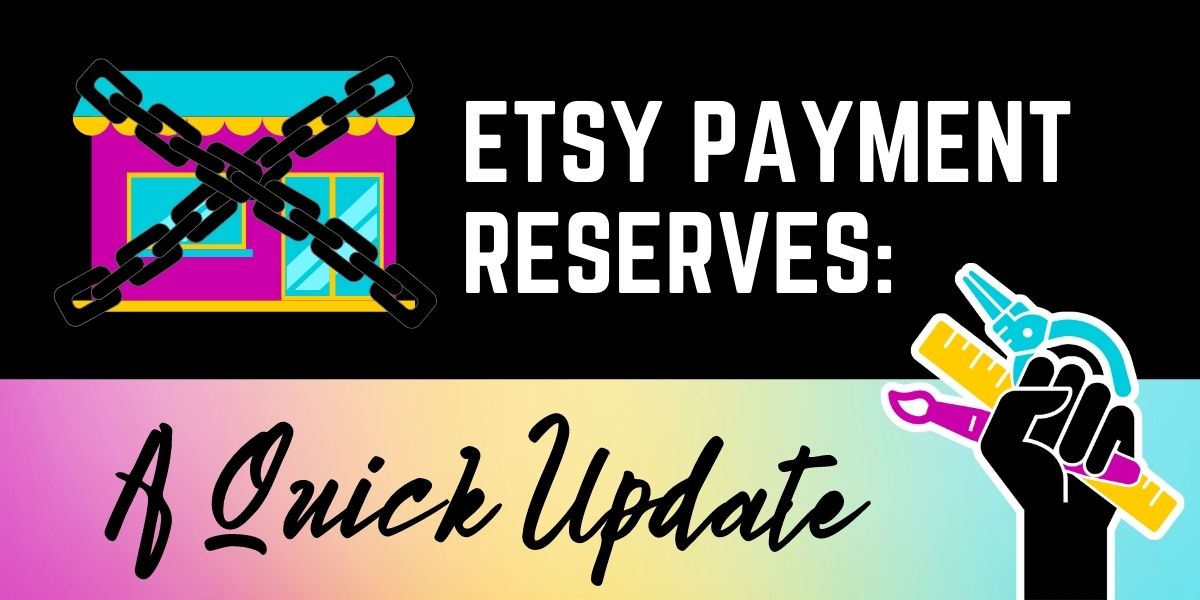Just wanted to post a quick update on the Etsy payment reserve policy situation. We filed complaints with both the FTC and the Small Business Association Office of Advocacy, so we will see if we get any response from that. The full text of our complaint is below, it’s the most recent summary of what has happened.
Thank you so much to everyone who responded to our quick survey about your reserve status, your answers really helped us be accurate in our complaint.
If you haven’t signed our petition yet, please do so at indiesellersguild.org/etsymustpay.
Finally, we had a meeting with Liz Barclay at the UK Small Business Commission and are looking at ways to work with sellers experiencing similar issues on other platforms to continue pressuring Big Tech to stop messing with our money! Stay tuned for more exciting news.
This complaint is being filed by the Indie Sellers Guild, an industry advocacy group for small, creative online business owners, on behalf of users of the Etsy marketplace platform.
Etsy.com is an e-commerce marketplace connecting sellers and consumers of handmade, vintage and craft goods. Sellers, the vast majority of which are independent small businesses, pay Etsy a fee in order to list their items for purchase on the site. When a consumer purchases an item, Etsy facilitates payment from buyer to seller, in exchange for a transaction fee collected automatically by Etsy.
However, beginning in May 2023, thousands of Etsy sellers found themselves placed on exorbitant “payment reserves,” where, on top of the standard transaction fees, Etsy temporarily withholds up to 75% of funds meant to be paid out to sellers after a successful transaction.
While the practice of reserving a portion of sales proceeds is generally standard in the e-commerce marketplace industry, the implementation of this policy on Etsy.com has placed an exceptional and undue burden on sellers, many of whom report being unable to sustain their businesses under the policy.
- On Etsy, the reserve amount is as high as 75% of the transaction total. This means Etsy withholds 75% of all funds collected, and then takes out taxes and fees from the remaining 25%. For small businesses that operate on a made-to-order basis, this often leaves sellers unable even to afford to purchase postage, let alone to make the product that has been ordered. These sellers find themselves in a catch-22: they can’t get paid until they make and ship orders, but they can’t make and ship orders without getting paid. . See our math tool here for a full breakdown.
- According to Etsy policy, the reserved payment is not released until after the item is confirmed to have shipped, or after 45 days. However, due to Etsy’s automated tracking system, businesses that opt for specialized delivery services or to deliver items themselves are unable to prove delivery, thus forcing them to wait a full 45 days to receive the money they have already been paid. Sellers and buyers are not given any opportunity to self-certify delivery.
- There are no clear, consistent guidelines listed by Etsy for why a seller will be placed on reserve. There are only stated risk factors. This makes it difficult or impossible for many sellers to determine what specific changes they need to make in order to comply. Small businesses that have been operating for years with no issues from customers have been determined “high risk” by this system and placed on reserve.
- Payment reserves can last 90 days or longer depending on Etsy’s discretion. There are no clear guidelines or explanations from Etsy as to why some reserves last longer than others.
- There is no customer service path for sellers to raise concerns or appeal a reserve if it was made in error. Sellers who contact Etsy customer service are told Etsy cannot tell why their shop was placed in reserve or what they need to do for the reserve to be removed.
We believe this practice is unfair to sellers, preventing their businesses from functioning and affecting their ability to fulfill orders, often resulting in businesses closing outright. This issue has already drawn media attention in the UK as well as the UK Small Business Commission and officials in Canada (BBC).
Etsy states that “fewer than 2% of active sellers had a reserve on their account at present.” (the Guardian). Yet Etsy currently has 6.30 million active sellers (Marketplace Pulse), the majority of whom are in the US, which means roughly 100,000 sellers have been put in this position. Our organization has collected stories and contact information from hundreds of sellers affected by this policy.
At the beginning of August, Etsy announced changes to the payment reserve policy to address these issues, but failed to give any specifics (Etsy). The same week, they sent an email to US sellers offering a cash advance through a third party lender, YouLend (Ecommercebytes). YouLend uses Plaid, another third party company that connects user’s bank accounts to apps. Plaid has had allegations of serious privacy violations. Etsy tried to require all US sellers to reverify their bank account using Plaid in 2022, despite widespread concerns from sellers over privacy and security. We believe that withholding sellers money through an extreme and vaguely defined payment reserves policy and then different sellers loans as a solution to their cash flow problem caused by the reserve policy is an egregious conflict of interest.
The Indie Sellers Guild
We are bringing this situation to your attention on behalf of Etsy sellers. Our organization has collected stories and contact information from dozens of sellers affected by this who have agreed to speak out. We would be happy to have those sellers file their own complaints or provide you with their contact information. We also have screenshots from sellers accounts and interactions with Etsy customer service documenting the situation.

